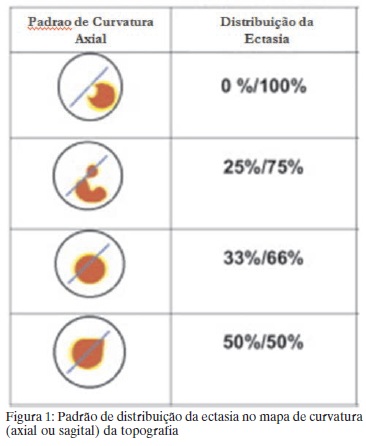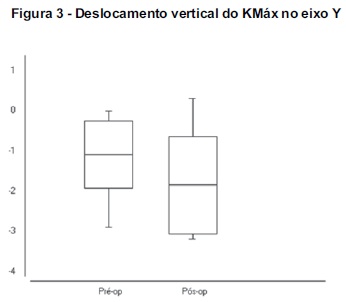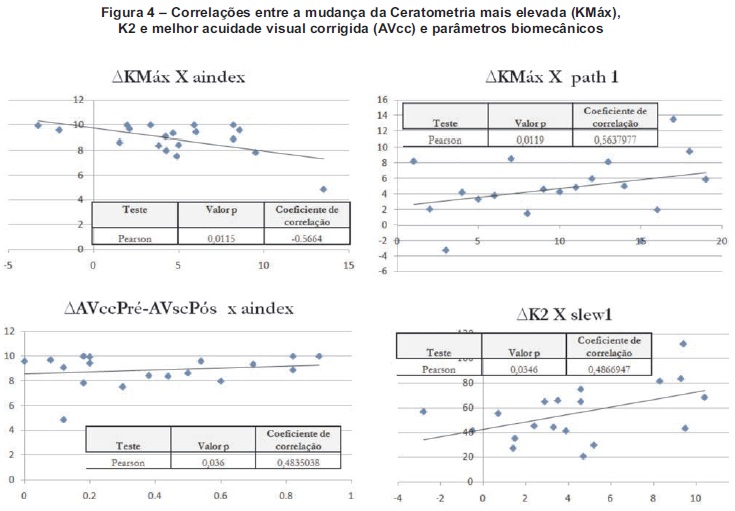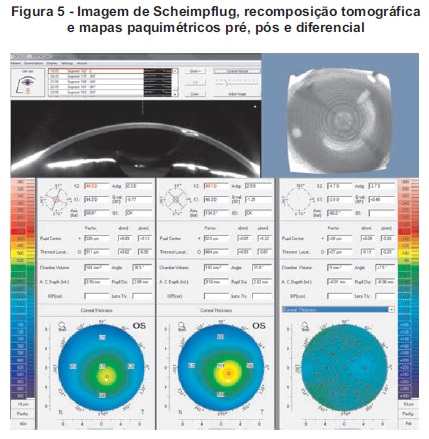OBJECTIVE: To verify possible correlations between the biomechanical state of the cornea before surgery and the results of stromal ring segments implant for keratoconus. METHODS: Nineteen eyes of 19 patients with keratoconus were evaluated before and 12 months after stromal ring segment implant surgery. The implant of one or two Ferrara ring segments was performed accordingly to the nomogram, considering corneal thickness, ectasy pattern on topography and astigmatism. The Wilcoxon test was performed to verify the differences between visual acuity (logMAR) with correction before surgery (AVccPre) and without correction (AVscPos) and with correction (AVccPos) after surgery, topography variables measured with Pentacam on pre and post operative and corneal biomechanics variables measure with ORA (ocular response analyzer). The absolute differences before and after the surgery (delta values - Δ) of variables with significant differences were calculated. The Δ values were correlated with the ORA measurements pre-operatively using Pearson or Spearman's tests, according with the distribution of the variables to be or not normal (Kolmogorov-Smirnov test). RESULTS: There were significant improvements on AVcc and AVscPos comparing with AVccPre (Wilcoxon test, p<0,05). Significant reduction was observed on keratometric astigmatism (AST), Keratometric central values (K1 and K2), higher keratometric value (KMax) and topometric indices: CKI (Center Keratoconus Index), IHD (Index of Height Decentration) and ISV (Index of Surface Variance) after surgery (Wilcoxon test, p<0.05). There was a significant increase in corneal thickness of 3.8 and 4 mm from the apex toward the temporal horizontal meridian observed a significant increase on cornea thickness, and there was significant downward displacement of the position of KMax (Wilcoxon test, p<0.05). No variable biomechanical statistically significant difference after surgery (Wilcoxon test, p>0.05). The ORA parameters derivate form the aplanation pressure: Corneal Hysteresis (CH), Corneal Resistance Factor (CRF) and the measures of the ocular pressure (IOPg and IOPcc) showed no significant correlations with the parameters delta (Δ). Fifteen of the 38 biomechanical variables derived from the sign of ORA corneal reflex presented significant correlation with at least one parameter Δ, highlighting the correlations between ΔKMax with aindex e path1 (Pearson test, p<0.05; r=-0.56 and 0.56 respectively) and between AVccPre-AVscPos and aindex (Pearson test, p<0.05; r=0.48). The variable that had the greatest number of significant correlations was w21, which correlated negatively with, ΔK2, ΔK1, ΔCKI and ΔKMax (Spearman test, p<0.05; r=-0.56; -0.55; -0.51 and -0.47) respectively. CONCLUSION: There is a significant improvement in visual acuity and keratometric parameters after surgery of implant the Ferrara ring segments for keratoconus. The improvement of several of these parameters with the surgery was significantly correlated with biomechanical characteristics derived from the signal of the ORA corneal reflex preoperatively. A biomechanical preoperative state "weaker" or "less resistant" was significantly related to greater clinical benefit of surgery. Analysis with multiple associations (multivariate) is necessary, including topographic parameters of the cornea and wavefront analysis of preoperative total. This information opens up new horizons for patient selection and planning of ring segments implant surgery for keratoconus.
Keratoconus; Cornea; Prostheses and implants; Visual acuity; Preoperative period; Treatment outcome










